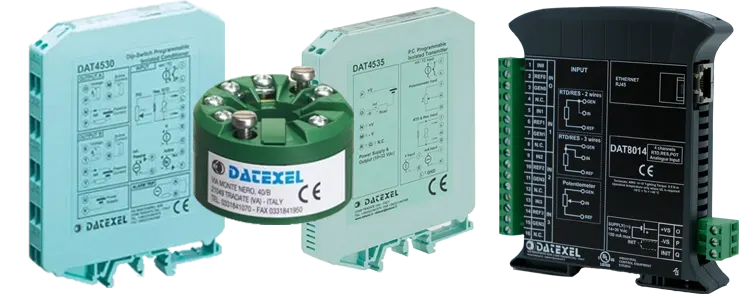RS485 Digital Input Output Module
DAT3188-4



The DAT3188-4 RS485 Digital I/O Module provides 4 digital inputs and 8 digital outputs, monitored and controlled via Modbus RTU/ASCII communication. It is designed for industrial automation systems that require compact digital I/O expansion over a Modbus network.
The 4 digital inputs can be used to monitor switches, sensors, or other contact signals. The 8 digital outputs are PNP transistor outputs (please confirm: PNP or NPN), suitable for driving indicators, relays, or low-power actuators.
The inputs and outputs are fully isolated from the Modbus communication line and the power supply, ensuring safe operation and noise immunity. The DAT3188-4 is also available in an RS-232 version for applications requiring serial communication.
| INPUT | OUTPUT | POWER SUPPLY |
|---|---|---|
| 4 Digital Inputs | 8 PNP Transistors | Power Supply Voltage 18-30Vdc |
| Modbus RTU/ASCII RS485 | Modbus RTU/ASCII RS485 | Reverse polarity protection 60Vdc |
| CURRENT CONSUMPTION | CONFIGURATION | ISOLATION |
| Between 60 and 115 mA | PC Programmable | Between Input/Comms/Power Supply 2000Vac. |
| EMC | HOUSING | TEMPERATURE |
| For Industrial environments | Material self-extinguishing | Operating Temperature 14°F +140°F -10°C +60°C |
| Immunity EN 61000-6-2 | Dimensions W x H x T 4" x 4 3/4" x 3/4" | Storage Temperature -40°F +185°F-40°C +85°C |
| Emission EN 6100-6-4 | 100 x 120 x 22.5 mm | Humidity (non condensing) 0-90% |
| Weight 3 oz 90 g |
| Digital Input | 4 Channels, Off State 0-3 V, On State 10-30V. |
| States | Off State 0-3 V, On State 10-30V. |
| Output | 8 Channels PNP Transistor. |
| States | 30 Vdc 500mA per channel. |
| Communication: | RS485 Modbus. |
| Power Supply: | Current 18 - 30 Vdc. Reverse polarity protection 60 Vdc. |
| Current Consumption: | 30 mA. |
| Temperature rating: | Operative Temperature -4°F +140°F -20°C +60°C Storage Temperature -40°F +185°F -40°C +85°C. |
| Humidity: | (not condensing) 0-90%. |
| Housing: | Material self-extinguishing. |
| Dimensions: | W x L x H 3 3/4X 3 1/2 X 1 7/8 inch, 90 x 74 x 48mm. |
| Weight: | 7 oz 200 g. |
| EMC. | For industrial environments. |
| Immunity: | EN 61000-6-2. |
| Emission: | EN 61000-6-4. |
| Isolation: | Between Modbus Master, Slave/Power supply 1500Vac, 50Hz, 1 Minute. |
| Configuration: | PC Configurable. |
| Input | |
| Digital Input 0 | Common 16 Input 12 |
| Digital Input 1 | Common 16 Input 13 |
| Digital Input 2 | Common 16 Input 14 |
| Digital Input 3 | Common 16 Input 15 |
| Digital Output 0 | Common 1 Input 2 |
| Digital Output 1 | Common 1 Input 3 |
| Digital Output 2 | Common 1 Input 4 |
| Digital Output 3 | Common 1 Input 5 |
| Digital Output 4 | Common 1 Input 6 |
| Digital Output 5 | Common 1 Input 7 |
| Digital Output 6 | Common 1 Input 8 |
| Digital Output 7 | Common 1 Input 9 |
| Power Supply (18-30Vdc). | Positive J Negative I. |
| RS 485 Slave | Positive (D+)B Negative (D-) A GND C |
| Init | Pin D Init Gnd C |
